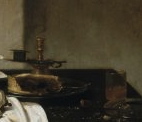Art and Food: 17th Century Dutch Still Lifes Good Enough to Eat
by Emily Contois
As the first summer session comes to a close, we’re all ruminating what we absorbed and discovered during the past six weeks of intense study. If you are a BU Gastronomy student and would like to share a few words on your summer session experience, please contact me!
What follows is a bit of what I learned in Professor Jonathan Ribner’s Art and Food course (ML 672), a class which sharpens the skills of critical observation, description, and analysis in a most delectable way…
Jan Jansz den Uyl’s Breakfast Still Life with Glass and Metalwork hangs in the Boston Museum of Fine Arts. Technically brilliant, this sumptuous and realistic still life depicts the trademark features of seventeenth century Dutch painting, using light, shadow, perspective, and reflection to create a work good enough to eat.
 Unlike other famed Dutch painters of the period, such as Pieter Claesz, den Uyl emphasizes vessels more so than edibles in this painting. The food appears entirely or partially eaten, leaving us to discern the character of the meal from the remaining vessels. The many fine dishes left askew on the table, including an elegant blue and white porcelain dish elevated near the center, indicate a high quality meal.
Unlike other famed Dutch painters of the period, such as Pieter Claesz, den Uyl emphasizes vessels more so than edibles in this painting. The food appears entirely or partially eaten, leaving us to discern the character of the meal from the remaining vessels. The many fine dishes left askew on the table, including an elegant blue and white porcelain dish elevated near the center, indicate a high quality meal.
 Notably, den Uyl also includes vanitas themes, elements that mark the passage of time and man’s mortality. Black wisps of smoke linger above a recently extinguished candle, marking both the end of this meal, which by the eaten food and toppled vessels has concluded hurriedly, and the end of life, which approaches us all. A pocket watch rests in the center foreground, tracking time as it marches forward with or without us.
Notably, den Uyl also includes vanitas themes, elements that mark the passage of time and man’s mortality. Black wisps of smoke linger above a recently extinguished candle, marking both the end of this meal, which by the eaten food and toppled vessels has concluded hurriedly, and the end of life, which approaches us all. A pocket watch rests in the center foreground, tracking time as it marches forward with or without us.
The positioning of the objects creates both drama and unity. While the layered positioning of the objects may appear at first glance haphazard, it is purposeful, creating a distinct, harmonious geometry. An ascending diagonal line of plates from the right converges with another diagonal line of toppled vessels from the left. Together they climb to an off center apex, crowned by a tall Venetian goblet of grey glass with a decorative swan head, which stands before an arched niche. This arch is also mirrored in the curved edges of the plates and vessels, while the vertically climbing diagonal lines of the piled plates runs nearly parallel to the rays of light streaming in from the left.
 In a most virtuosic endeavor, den Uyl paints not only an empty glass goblet of grey glass, which reflects the light off its convex surface, but by laying the goblet on its side, he also portrays the metallic surface of the pewter flagon and the copper tazza as seen through the glass of the goblet itself. Placing the goblet and tazza on their side, den Uyl creates unexpected angles from which to view the items, including the reverse engraving inside the base of the tazza, viewed from underneath. Because the artist’s last name means owl in Dutch, he often whimsically signs his works with hidden owls, as seen at the top of the handle of the large pewter flagon at the left.
In a most virtuosic endeavor, den Uyl paints not only an empty glass goblet of grey glass, which reflects the light off its convex surface, but by laying the goblet on its side, he also portrays the metallic surface of the pewter flagon and the copper tazza as seen through the glass of the goblet itself. Placing the goblet and tazza on their side, den Uyl creates unexpected angles from which to view the items, including the reverse engraving inside the base of the tazza, viewed from underneath. Because the artist’s last name means owl in Dutch, he often whimsically signs his works with hidden owls, as seen at the top of the handle of the large pewter flagon at the left.
This large and dramatic den Uyl painting commands the wall where it hangs at the MFA. It not only realistically reproduces the world as the eye sees it, but also renders the food, plates, goblets, and utensils depicted more astounding on the canvas than they appear on our own breakfast tables.
The Museum of Fine Arts is located at 465 Huntington Ave., Boston. The museum is open Monday, Tuesday, Saturday, and Sunday from 10 a.m. to 4:45 p.m., and Wednesday through Friday from 10 a.m. to 9:45 p.m. Admission is free with BU ID, $20 without student ID, and $22 for adults; free to the public on Wednesday evenings. By public transportation, take the Green Line E trolley or the number 39 bus to the Museum of Fine Arts stop or the Orange Line train or bus routes 8, 47, or C2 to the Ruggles stop.
If you are unable to visit Boston, you can view many MFA collections online, including the Northern European collection, which features several seventeenth century Dutch still life works of note.
Emily is a current gastronomy student and graduate assistant, editing the Gastronomy at BU blog, January-August, 2012. Check out her research in food studies, nutrition, and public health on her blog, emilycontois.com.